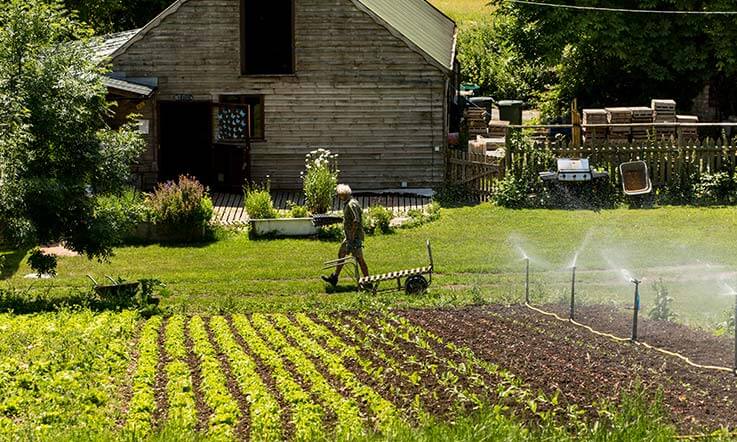ORC’s Farm Sustainability Researcher Christian Gossel reports back on the key messages from the 38th annual meeting of the Farm Woodland Forum that he attended with Will Simonson.
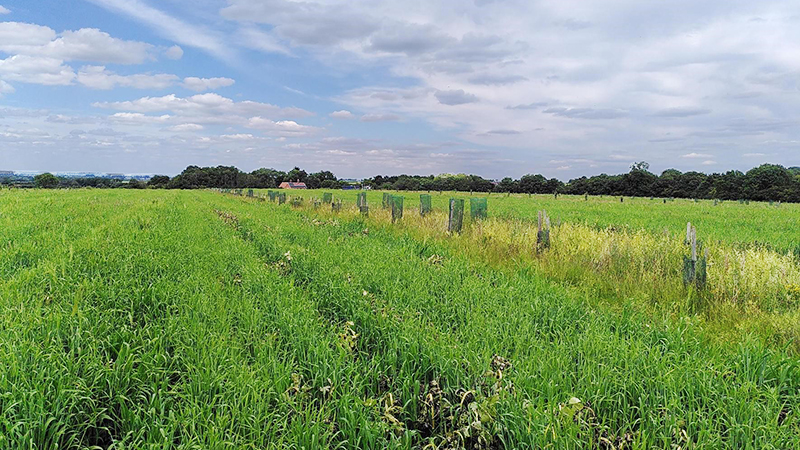
Hosted by Paul Burgess at Cranfield University, the meeting gathered about 45 people mostly from the research community but also including farmers and policy makers. The theme was agroforestry for food, net zero and biodiversity and the range of talks and posters covered all these aspects. They also encompassed a range of scales from field and farm, through landscape to national and even continental level.
The field-scale papers reported on studies characterising and quantifying changes that happen when you plant trees into farmland. These often adopted a space-for-time approach in which measurements were made at different distances along transects running out from the tree rows into the alleys of typical silvo-arable systems. It was notable that in the UK context these studies converged on the same sites: there are few options to choose from if one wants to look at the effect of big trees. It was good to hear of a variety of sampling methods for biodiversity, and innovative ways of handling the data collected, with Alexa Varah from the Natural History Museum talking about species density profiles (encompassing a range of diversity indices) rather than plumping for just one. Another biodiversity study – Beth Evans, again from the Museum – focused on the meso-fauna of soils (mites, springtails, worms and suchlike). In her case, the only significant difference between agroforestry systems and ‘control’ fields without trees were to be found in the tree rows themselves, i.e. not in the alleys between the trees.
Tying in with these studies, in her PhD work ex-ORC researcher Sally Westaway found that biodiversity benefits were one of the main drivers for farmers adopting agroforestry in the UK. Such benefits were also among the aspects captured in a farmer-friendly agroforestry tree species guide presented by Tom Staton as part of Defra/Forestry Commission’s Expanding Agroforestry project. Based on a rapid literature review, the guide features 33 trees, both natives and exotic, that are common in agroforestry, and for each one there are two pages of information using a traffic light system to score the trees across different attributes of suitability and productivity. Whilst aimed as a decision-making tool the work is also of scientific interest, discovering for example that trees that are good for wildlife tend to be less resilient to climate change, and that trees good for locking up carbon tend to provide lots of other ecosystem services. These trade-offs and synergies themselves have practical application, influencing the tree choice of farmers.
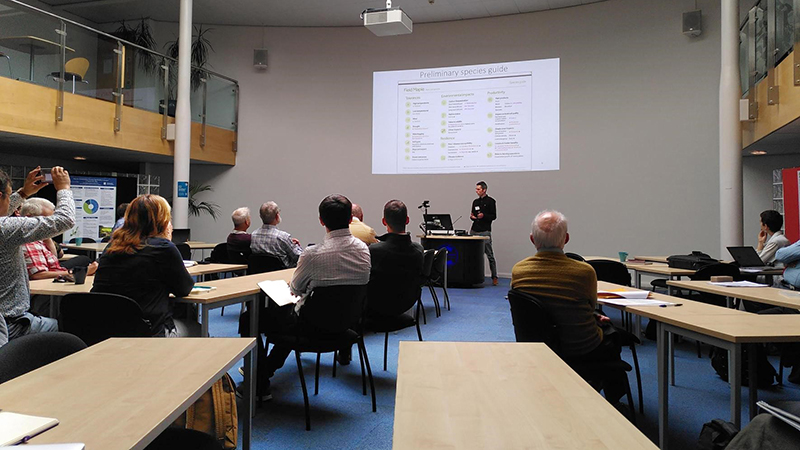
At the larger scale, we had a presentation by Prof Steve Newman on developing an agroforestry vision for the county of Hampshire, complementing the largest silvo-pastoral system in the country (the New Forest) with forest villages and peri-urban forest gardens. At national scale, Arina Machine of Leicester University described the challenges of quantifying how much agroforestry there is in the UK. In her PhD research she has used the European LUCAS dataset but finds in its photo-interpretation methodology causes of bias in the results. Once corrected, clearer trends emerge, with varying amounts of decline and stablization across different parts of the UK, related not so much to changes in tree cover than to trends in grazing levels – the presence of grazing in fields with trees being the key determinant of agroforestry. But in discussion the important difference between agroforestry landscapes and agroforestry systems was noted, the latter but not necessarily the former being based on the intentional integration of trees into the farming system for the benefits they bring.
Perhaps the last note should go to the agroforestry project being set up at Spains Hall Estate in Essex. Described by the estate director and manager Archie Ruggles-Brise, this system breaks the mould in terms of scale (6000 walnuts, hazelnuts and oaks across 167 ha already planted) and even definition: with the sole food crop coming off the trees, and the alleys planted with diverse leys for birds and other biodiversity, it is more silvo-fallow than silvo-arable or any other recognised category.
The second day was dedicated to farm visits. Medbury Farm is tenanted by Mark and Kier Hall in Bedfordshire. Mark shared the work he’s been doing to reduce emissions, such as utilising precision technology for fertiliser spreading. A key part in this was the planting of 4 km of hedgerows and woodland through the farm as part of a scheme offered by the Forest of Marston Vale. James Russell from the Forest of Marston Vale provided additional insight into the scheme offer. Key points were the flexibility for designs and species, results-based payments, and 15 years of maintenance payments with an offer for the Forest of Marston Vale team to undertake the planting and management for the first 3 years. Another key aspect was limiting the amount of paperwork that farmers had to deal with, making integrating trees into their farms as easy as possible for the farmers.
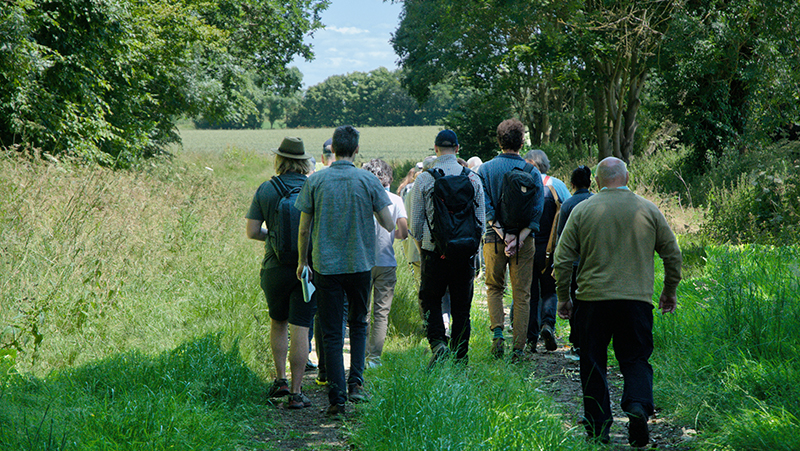
The RSPB’s Hope Farm. was up next. Unlike some farms linked to organisations, Hope farm is largely independent from the RSPB and required to turn its own profit while also providing a home for wildlife. Georgie Bray and her team explained the history of the farm followed by a visit into the field to see the silvoarable system. After much research they planted three types of rows in one of their fields, a row of apple trees, a row of native hardwoods, and a row of hazels and cobnuts. Interestingly the trees are planted in strips 6 meters wide. This not only provides ample room for wildflowers underneath but allows for machinery to travel along the undergrowth in winter, minimising poaching and vastly improving the ability to prune and maintain the trees. The farm has been transparent in its failings too. On reflection they would have fenced off the entire strip rather than individual tree guards. The supposed threat of deer has also not been realised at this particular farm, meaning a lower, wider guard could have been used which would make pruning and weed management easier. Elsewhere they have explored different types of hedgerow management. The first attempt used traditional laying techniques to build a woven hedge. While attractive and effective, the time taken to complete a small stretch meant it wasn’t feasible to do at large scale. Instead a more mechanical approach was trialled which simply pushed the overgrowth down, allowing the main stems to regrow and providing additional habitat in the dead hedge which was left to the side.
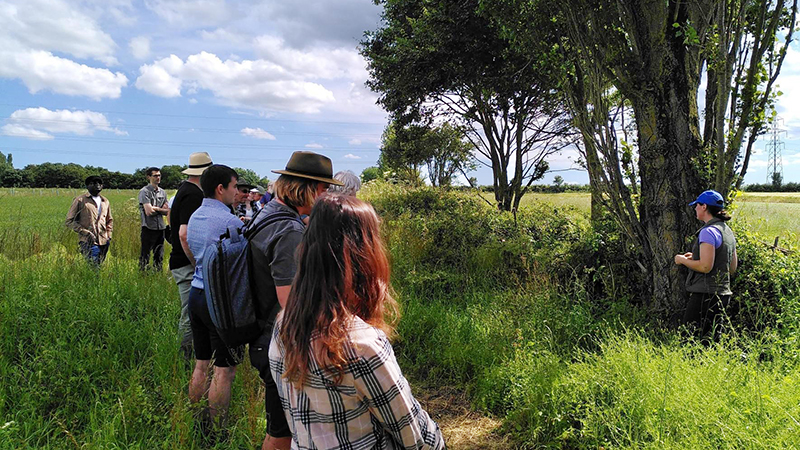
The two days provided a fantastic opportunity to learn about the latest research in agroforestry across the UK, Europe, and Internationally, while also understanding the practical applications of trees on farms. Next year’s meeting is due to be held in Scotland and if it’s anything like this year then it promises to be well worth the trip north.
See Christian’s poster on ‘Aiming High for Hedgerow’s here and find more on the project here
For more reports and presentations see: https://www.agroforestry.ac.uk/meetings/annual-meeting-2024
